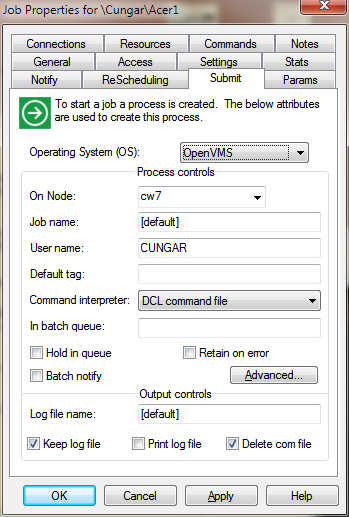This submission dialog is displayed for any OpenVMS job

Field |
Description |
On Node |
This specifies on which node this job is to execute. Inside a cluster, any node that is a member of the same cluster is allowed to submit and execute the job. This parameter is very useful in a "Satellite/Central database" network configuration. In this network topology, the job will execute on the remote node. All the control data and commands will come from the central database. |
Job name |
This defines the job name that is to be assigned this job when it is in the batch execution queue. This name will only appear when you use the VMS command SHOW ENTRY or SHOW QUEUE. By default this name is the same as the job entry in the SCHEDULE database. |
Command Interpreter |
Command interpreter to be used to process the job commands. Choices are: DCL command file - Default DCL command line. Schedule pseudo terminal - Process an output file produced using the EnterpriseSCHEDULE pseudo terminal procedure Schedule pseudo terminal@ - Process an output file produced using the EnterpriseSCHEDULE pseudo terminal procedure as a subprocedure |
In batch queue |
This defines what batch queue the job is to be placed in for execution. This can be either a generic or node specific execution queue. The default if none has been defined either implicitly or explicitly is SYS$BATCH. |
Process flags (checkboxes) |
Hold in Queue - Place the job in the PENDING state on entering into the batch queue. Retain on Error - Keep the log file on line after the job finishes. Batch notify - Notify via batch |
Log file name |
This specifies where to place the job log file that is created during job execution. Any file name that is provided is parsed and a default location is used to complete any missing elements. |
Output flags (checkboxes) |
Keep log file - Keep log file upon completion Print log file - Print the log file on completion Delete com file - Delete the job temporary COM file on completion. Hold in Queue - Place the job in a hold state until release Retain on Error - Retain a temporary job in case of error |

Advanced options (click on Advanced button) |
|
Characteristics |
This is a single known characteristic name that is to be associated with the job when it is submitted. Characteristics are arbitrary attributes that can be assigned to job queues. A job will only execute in a queue with matching characteristics. |
CPU Time Limit |
This specifies the maximum CPU time that the job will execute. The batch queue also has a CPU time limit the smaller of the two is used. If none is specified this implies NO LIMIT. The field contains a standard delta date specification. This value places a hard limit on the jobs execute time limited |
Print Queue |
This defines which print queue that the log file, if it is to be printed, is to be inserted into. The default if none has been defined either implicitly or explicitly is SYS$PRINT. |
Account name |
This specifies what account value to assign the job when it is submitted for execution. This parameter is only useful if you have an application that can use this value. |
Command interpreter |
This specifies which command language interpreter will be enabled for the batch job. The default value is DCL. |
Queue priority |
This specifies what queue priority to assign this job when it is inserted into the batch queue for execution.The priority is NOT the execution priority but strictly the priority used to order jobs in the batch execution queue while they are waiting to start. |
Working set default |
This defines for a batch job a working set default and the default number of physical pages that the job can use. If the queue on which the job executes has a nonzero default working set, the smaller of the specified job and queue values is used. If the queue on which the job executes has a working set default of 0, the smaller of the specified job and UAF values (value established in the user authorization file) is used. If you specify the value 0 or NONE, the specified queue or UAF value is used. |
Working set quota |
This defines for the batch job a working set quota and the amount of physical memory that the job is guaranteed. If the queue on which the job executes has a nonzero working set quota, the smaller of the specified job and queue values is used. If the queue on which the job executes has a working set quota of 0, the smaller of the specified job or the value established in the user authorization file (UAF) is used. If you specify the value 0 or NONE, the specified queue or UAF value is used. |
Working set extent |
This defines for the batch job a working set extent and the maximum amount of physical memory that the job can use. The job uses the maximum amount of physical memory only when the system has excess free pages. If the queue on which the job executes has a nonzero working set extent, the smaller of the specified job and queue values is used. If the queue on which the job executes has a working set extent of 0, the smaller of the specified job and the value established in the user authorization file (UAF) is used. If you specify the value 0 or NONE, the specified queue or UAF value is used. |